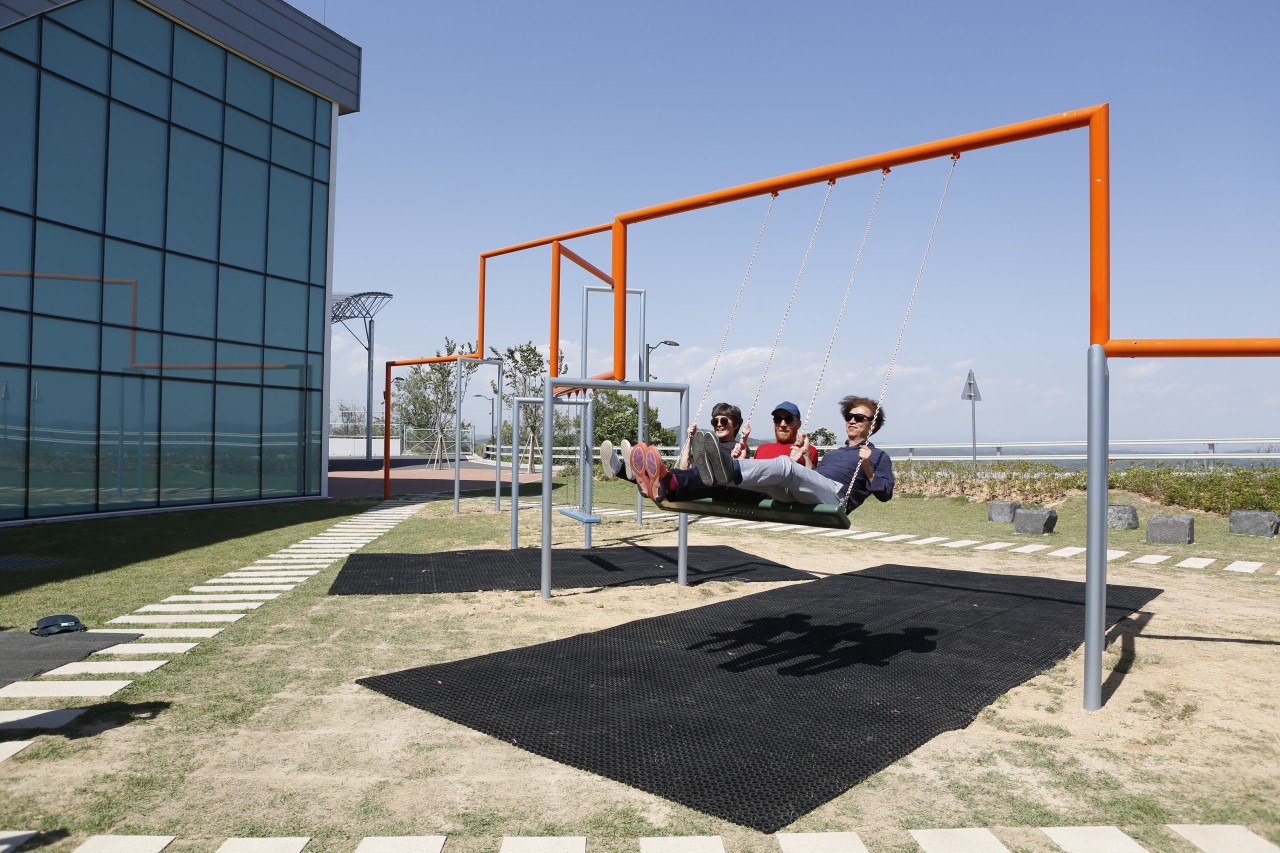Swinging times in the DMZ
Superflex installation that filled the Turbine Hall in London's Tate Modern finds a new location a long way from home
By Shim Woo-hyunPublished : May 22, 2019 - 15:59
You can ride on a swing in the Demilitarized Zone along the border between the two Koreas, and it’s even a three-seater.
Danish artist group Superflex’s two-swing set from their 2017 large-scale installation “One Two Three Swing!” has been installed at Dora observatory situated at the northernmost point of the DMZ, in Paju, Gyeonggi Province.
Danish artist group Superflex’s two-swing set from their 2017 large-scale installation “One Two Three Swing!” has been installed at Dora observatory situated at the northernmost point of the DMZ, in Paju, Gyeonggi Province.

Tourists and soldiers visiting Dora observatory were swinging under blue-clear sky on Tuesday. Taking pictures of them was Jakob Fenger, who founded Superflex along with Rasmus Nielsen and Bjornstjerne Christiansen in 1993.
“It’s a magical moment (to seeing the work being installed at the site),” Fenger said during a press conference held on Tuesday at Dora observatory in the DMZ, which overlooks various locations in North Korea, including the downtown of Gaeseong, Songaksan on the backdrop, Kim Il-Sung Statue, cooperation farms and so on.
The swing set installed at the northernmost part of South Korea was part of the artist group’s large-scale playground installed at Tate Modern’s Turbine Hall. The Tate installation, which was commissioned by Hyundai Motor, comprised of some 20 swing sets hanging from orange-colored pipes that zig-zag around the huge gallery space. The exhibition, held until April 2018 at Tate Modern, also had a huge mirrored pendulum hanging from the 20-meter-high ceiling of the hall, as well as thick carpet in candy-stripes, which covered up the floor.
The swing set has been traveling the world since then, and Dora Observatory is its fifth destination, said Kim Sun-jung, president of the Gwangju Biennale Foundation. It is also the farthest location from where it was first introduced, she added.
The idea behind installing the swing-set in different locations around the globe is to connect people from many parts of the world, and also to go through barriers in both literal and figurative ways -- like it broke through the walls of Tate Modern’s Turbine Hall.
The orange-colored tubes appear to grow out of the ground and move back in, and they may also come out of any different sites.
North Korea is the location that the artist now dreams to install what Fenger calls “sculpture infrastructure,” as the Danish trio believe that culture can bring societal change.
Fenger, who said the word “tool” was a more apt description of their work than “art,” said that they want their creations to bring people together and get them involved in physical activities, which will also make them think in turn.
The three-seater is an apparent way to bring people together. According to the artist, three is the minimum number to make up a group.
The latest project has been organized by Real DMZ Project and supported by the Gwangju Biennale Foundation on the occasion of the 60th anniversary that celebrates the diplomatic ties between Denmark and Korea.
The two swing-set will be open to the public for two years.
By Shim Woo-hyun(ws@heraldcorp.com)








![[Graphic News] More Koreans say they plan long-distance trips this year](http://res.heraldm.com/phpwas/restmb_idxmake.php?idx=644&simg=/content/image/2024/04/17/20240417050828_0.gif&u=)
![[KH Explains] Hyundai's full hybrid edge to pay off amid slow transition to pure EVs](http://res.heraldm.com/phpwas/restmb_idxmake.php?idx=644&simg=/content/image/2024/04/18/20240418050645_0.jpg&u=20240419100350)






![[From the Scene] Monks, Buddhists hail return of remains of Buddhas](http://res.heraldm.com/phpwas/restmb_idxmake.php?idx=652&simg=/content/image/2024/04/19/20240419050617_0.jpg&u=20240419175937)

![[KH Explains] Hyundai's full hybrid edge to pay off amid slow transition to pure EVs](http://res.heraldm.com/phpwas/restmb_idxmake.php?idx=652&simg=/content/image/2024/04/18/20240418050645_0.jpg&u=20240419100350)

![[Today’s K-pop] Illit drops debut single remix](http://res.heraldm.com/phpwas/restmb_idxmake.php?idx=642&simg=/content/image/2024/04/19/20240419050612_0.jpg&u=)